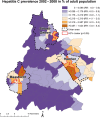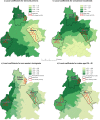The Spatial Distribution of Hepatitis C Virus Infections and Associated Determinants--An Application of a Geographically Weighted Poisson Regression for Evidence-Based Screening Interventions in Hotspots
- PMID: 26352611
- PMCID: PMC4564162
- DOI: 10.1371/journal.pone.0135656
The Spatial Distribution of Hepatitis C Virus Infections and Associated Determinants--An Application of a Geographically Weighted Poisson Regression for Evidence-Based Screening Interventions in Hotspots
Abstract
Background: Hepatitis C Virus (HCV) infections are a major cause for liver diseases. A large proportion of these infections remain hidden to care due to its mostly asymptomatic nature. Population-based screening and screening targeted on behavioural risk groups had not proven to be effective in revealing these hidden infections. Therefore, more practically applicable approaches to target screenings are necessary. Geographic Information Systems (GIS) and spatial epidemiological methods may provide a more feasible basis for screening interventions through the identification of hotspots as well as demographic and socio-economic determinants.
Methods: Analysed data included all HCV tests (n = 23,800) performed in the southern area of the Netherlands between 2002-2008. HCV positivity was defined as a positive immunoblot or polymerase chain reaction test. Population data were matched to the geocoded HCV test data. The spatial scan statistic was applied to detect areas with elevated HCV risk. We applied global regression models to determine associations between population-based determinants and HCV risk. Geographically weighted Poisson regression models were then constructed to determine local differences of the association between HCV risk and population-based determinants.
Results: HCV prevalence varied geographically and clustered in urban areas. The main population at risk were middle-aged males, non-western immigrants and divorced persons. Socio-economic determinants consisted of one-person households, persons with low income and mean property value. However, the association between HCV risk and demographic as well as socio-economic determinants displayed strong regional and intra-urban differences.
Discussion: The detection of local hotspots in our study may serve as a basis for prioritization of areas for future targeted interventions. Demographic and socio-economic determinants associated with HCV risk show regional differences underlining that a one-size-fits-all approach even within small geographic areas may not be appropriate. Future screening interventions need to consider the spatially varying association between HCV risk and associated demographic and socio-economic determinants.
Conflict of interest statement
Figures
References
-
- Shepard CW, Finelli L, Alter MJ (2005) Global epidemiology of hepatitis C virus infection. Lancet Infect Dis 5: 558–567. - PubMed
-
- Perz J. Estimated global prevalence of hepatitis C virus infection; 2004. Idsa.
-
- (1998) Recommendations for prevention and control of hepatitis C virus (HCV) infection and HCV-related chronic disease. Centers for Disease Control and Prevention. MMWR Recomm Rep 47: 1–39. - PubMed
-
- Gebo KA, Bartlett JG (2002) Management of hepatitis C: a review of the NIH Consensus Development Conference. Hopkins HIV Rep 14: suppl i–iv. - PubMed
-
- Alter MJ, Margolis HS, Bell BP, Bice SD, Buffington J, et al. (1998) Recommendations for prevention and control of hepatitis C virus (HCV) infection and HCV-related chronic disease. MMWR Morb Mortal Wkly Rep 47 - PubMed
MeSH terms
LinkOut - more resources
Full Text Sources
Other Literature Sources
Medical




